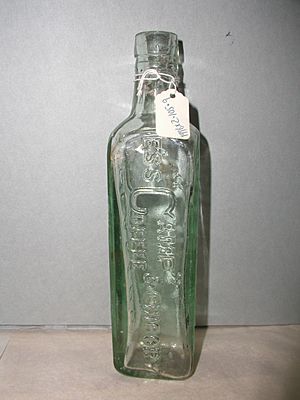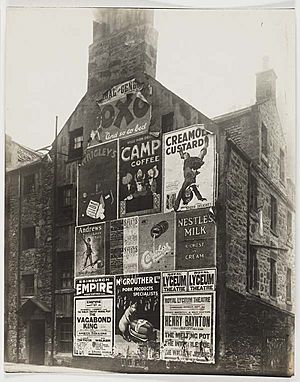Camp Coffee facts for kids
Camp Coffee is a special syrup from the United Kingdom. It mixes coffee and a plant called chicory. This dark, sweet syrup was first made in 1876 in Glasgow. While it was originally meant to be a quick way to make coffee, today it's mostly used in baking. Many people add it to cakes and other sweet treats.
Over the years, the company that makes Camp Coffee has changed hands. In 1984, a big company called McCormick & Company bought it. Now, Camp Coffee is made in Paisley, Renfrewshire.
What is Camp Coffee?
Camp Chicory & Coffee is a thick, dark brown liquid. It's made from sugar, water, chicory extract, and dried coffee extract. Chicory is a plant whose roots can be roasted and ground. They taste a bit like coffee.
This syrup has a smooth taste of both chicory and coffee. It's also very sweet. You can mix Camp Coffee with hot water or warm milk to make a drink. It's a bit like making hot chocolate. You can also add it to cold milk and ice for an iced coffee. However, you will most often find it in the baking aisle of supermarkets. This is because it's a popular ingredient for making coffee cakes and other desserts.
The Story Behind Camp Coffee
Camp Coffee was created in 1885 by Campbell Paterson. His company, R. Paterson & Son, was known for making sweet syrups. Campbell Paterson developed the coffee syrup for people to use at home. Back then, making coffee needed special and expensive equipment. This syrup made it much easier.
There's a famous story about Camp Coffee, mostly because of the picture on its label. Many people thought it was made for soldiers. The label shows a Scottish soldier from the Gordon Highlanders. He is sitting down, and a Sikh soldier is serving him. They are in front of a tent, and a flag flies above it. The flag says "Ready Aye Ready." This was also the motto of a British Indian Army group called the 59th Scinde Rifles (Frontier Force). In this motto, "aye" means "always," so it means "always ready." For the drink, it meant it was "always ready" to be made.
The first label was designed by William Victor Wrigglesworth. It showed the Sikh soldier serving the Scottish soldier. On the tray the Sikh soldier carried, there was a bottle of Camp Coffee. And on that bottle, there was the same label, showing another bottle, and so on. This is called the Droste effect. Later, in the mid-1900s, the label was changed. The tray was removed, so the endless bottles disappeared. This change was made to make it seem less like the Sikh was a servant.
Since 2006, the label has changed again. Now, the Sikh is shown as another soldier sitting next to the Scottish soldier. They both have their own cups of coffee.
Why People Still Love It
Camp Coffee brings back many happy memories for people in Britain. Many adults remember it from their own childhoods. It's a part of British nostalgia.
Today, it's still a very popular ingredient for people who love to bake at home. They use it to make delicious coffee-flavored cakes and coffee-flavored buttercream frosting. In the late 1970s, Camp Coffee even became a popular choice when regular instant coffee became very expensive due to coffee shortages.
See also





